 |
 |
 |
| |
Hospitalizations among HIV Controllers versus Persons with
Medically-Controlled HIV - Hospital Admission Rate Same for
No-ART and ART HIV Controllers in US Military
|
| |
| |
Download the PDF here
IAS 2015, July 19-22, 2015, Vancouver
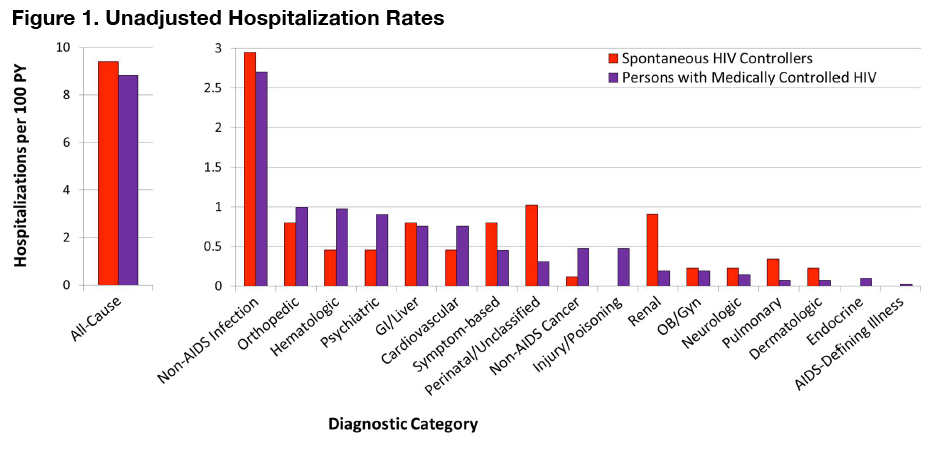
-------------
Hospital Admission Rate Same for No-ART and ART HIV Controllers in US Military
IAS 2015, July 19-22, 2015, Vancouver
Mark Mascolini
People with antiretroviral therapy (ART)-controlled HIV infection in a US military study had a hospital admission rate similar to that of people who controlled their HIV without ART, including a set of elite controllers [1]. The findings differ from a recent study by some of the same investigators in which elite controllers in a civilian HIV cohort had a 77% higher all-cause admission rate than people with ART-controlled HIV--and a 3 times higher cardiovascular admission rate [2]. Age could explain the differences between results of the two studies.
The researchers noted that HIV controllers, who maintain low or undetectable viral loads without ART, have more inflammation and immune activation than people without HIV and so may run a higher risk of cardiovascular disease and hospital admission. They conducted this study to compare all-cause and cause-specific hospital admission rates in HIV controllers and people with ART-controlled HIV in the US Military HIV Natural History Study, which includes military personnel and their beneficiaries.
The researchers split HIV controllers into two groups--viremic controllers (3 or more viral loads at or below 2000 copies over 12 months or more without ART) and elite controllers (3 or more undetectable viral loads over 12 months or more without ART). They compared these no-ART controllers with people who had ART-controlled HIV infection (3 or more viral loads below 400 copies over 12 months or more starting 1 year after they began continuous ART). The researchers assigned reasons for hospital admission according to the first-listed Natural History Study diagnostic code, and they used binomial regression models to estimate incidence rate ratios (IRR) comparing admission rates in HIV controllers and ART controllers.
Among 3106 military personnel in care from 2000 through 2013, the researchers counted 221 HIV controllers, including 33 elite controllers (1.1%) and 188 viremic controllers (6.0%). There were 870 people (28%) with ART-controlled HIV. High proportions of the HIV controllers and ART controllers were 18 to 29 years old (60.6% and 53.2%) or 30 to 44 years old (37.1% and 39.0%). Respective proportions of men were 89.1% and 94.7%. Proportions of whites, blacks, and Hispanics among HIV controllers were 33.9%, 54.3%, and 6.8% and among ART controllers 39.9%, 40.1%, and 12.8%. Higher proportions of HIV controllers than ART controllers had a CD4 count above 750 at HIV diagnosis (29.4% versus 9.0%) or between 501 to 750 at diagnosis (46.6% versus 27.2%). And higher proportions of HIV controllers had a viral load below 400 copies at diagnosis (31.7% versus 4.3%) or between 401 to 2000 copies at diagnosis (23.1% versus 5.5%).
Hospital admission rates averaged 9.4 per 100 person years in HIV controllers and 8.8 per 100 person-years in people with ART-controlled HIV. Both rates mean about 9 of every 100 people got admitted to the hospital every year. The adjusted incidence rate ratio (aIRR) comparing admissions of HIV controllers versus ART controllers showed that the difference was nonsignificant (aIRR 1.15, 95% confidence interval 0.80 to 1.65).
Non-AIDS infections proved by far the most frequent causes of admission in both groups, with rates exceeding 2.5 per 100 person-years. The next most frequent admission reasons were orthopedic, hematologic, psychiatric, and gastrointestinal/liver. Admission rates were substantially higher in the ART-controlled group than among HIV controllers for hematologic causes, psychiatric problems, and non-AIDS cancers. HIV controllers had a higher admission rate for kidney complications. Admissions for cardiovascular disease did not differ much between groups (below 1 per 100 person-years in both groups.) The researchers did not present statistical analyses of these differences in cause-specific admissions.
In all study participants, age 60 or older (compared with 18 to 29) more than doubled the risk of hospital admission (aIRR 2.16, 95% CI 1.01 to 4.63). A CD4 count at or below 200 (versus above 750) boosted the admission risk more than 2.5 times (aIRR 2.56, 95% CI 1.46 to 4.57). HIV infection for more than 15 years raised the admission risk 3.5 times in univariate analysis but not in the adjusted analysis.
The researchers observed that the overall hospital admission rate "in this young, healthy cohort of military personnel and beneficiaries was lower than that observed in other cohorts of persons living with HIV." For example, in a similar analysis of the civilian HIV Research Network cohort, admission rates were 23.3 per 100 person-years for elite controllers, 77% higher than the rate of 10.5 per 100 person-years for ART controllers (aIRR 1.77, 95% CI 1.21 to 2.60).[2]. In the same study, elite controllers had more than a tripled risk of cardiovascular admissions compared with ART controllers (aIRR 3.19, 95% CI 1.50 to 6.79) and a quadrupled risk of psychiatric admissions (aIRR 3.98, 95% CI 1.54 to 10.28). Median age was much higher in the HIV Research Network cohort than in the military study--46.4 years among elite controllers and 45.4 years among ART controllers.
References
1. Crowell T, Ganesan A, Berry S, et al. Hospitalizations among HIV controllers versus persons with medically-controlled HIV. IAS 2015. 8th Conference on HIV Pathogenesis, Treatment and Prevention. July 19-22, 2015. Vancouver. Abstract MOPEB152.
2. Crowell TA, Gebo KA, Blankson JN, et al. Hospitalization rates and reasons among HIV elite controllers and persons with medically controlled HIV infection. J Infect Dis. 2015;211:1692-1702.
----------------------
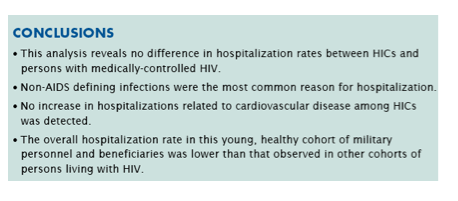
Hospitalizations among HIV Controllers versus Persons with Medically-Controlled HIV
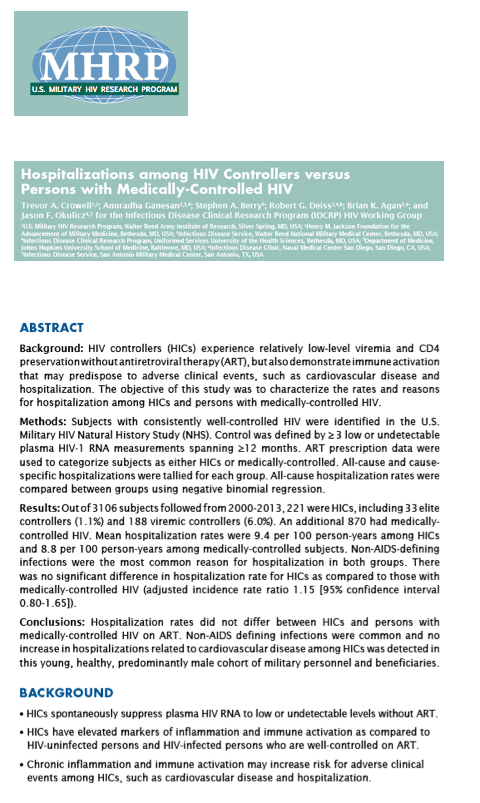
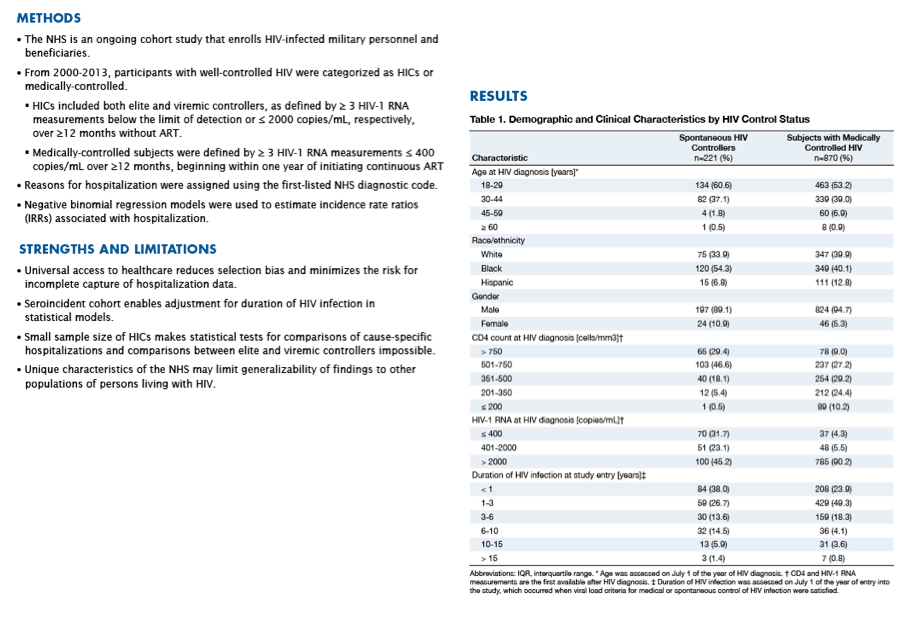
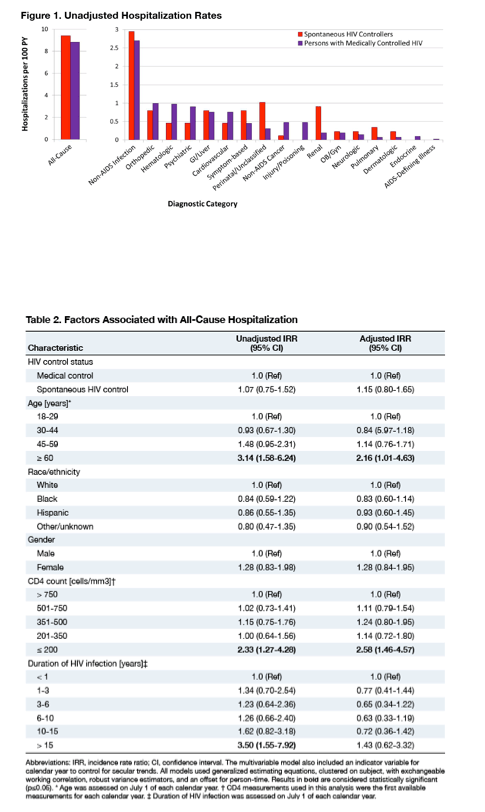
|
| |
|
 |
 |
|
|